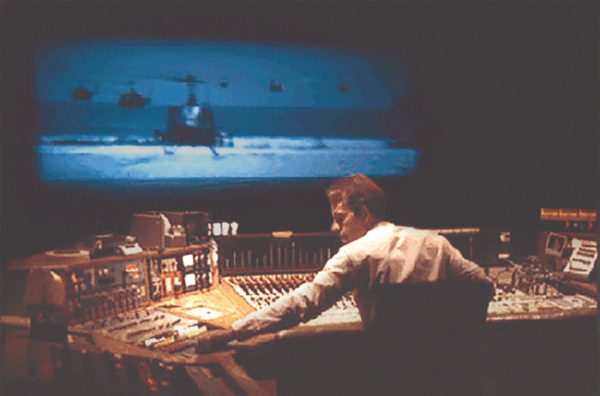First there was Visions of Light: The Art of Cinematography (1992), a documentary overview of the great DPs in movie history. Then came The Cutting Edge: The Magic of Movie Editing (2004), and Score: A Film Music Documentary (2016). Now, motion picture sound designers and mixers get their due in Making Waves: The Art of Cinematic Sound, which had its world premiere last night at New York’s Tribeca Film Festival.
The director, Midge Costin, knows the subject well: She’s been a Hollywood sound editor for over 25 years, and is the Kay Rose professor in the art of sound at the USC School of Cinematic Arts. A nine-year passion project, Making Waves makes a cogent argument that sound is “half the experience” of a movie, as George Lucas observes (and, indeed, the later clips offer proof that Star Wars wouldn’t be Star Wars without its pioneering sound effects). The film begins poetically by noting that our first experience of life is via the sounds we hear in the womb. And often the word “subliminal” comes up to describe the stealthy impact of audio and perhaps explain why it’s so often taken for granted.
The film acknowledges the early audio innovations of films like King Kong and Citizen Kane, but the true revolution happened with the introduction of Dolby noise reduction and the more widespread adoption of stereo sound in the mid-’70s. One of the driving forces at the time was Barbra Streisand, who says she was prepared to spend $1 million of her own money on the four-month stereo mix of her A Star Is Born. (The studio agreed to foot the bill after they heard the final results.) Among the major innovators of that era were Robert Altman, who miked every actor in his ensemble for the dense multi tracks in Nashville; Francis Ford Coppola, orchestrating the sounds of war and chaos in Apocalypse Now; and David Lynch, who, with Alan Splet, created bizarre soundscapes on a shoestring budget in Eraserhead.
One by one, Costin’s film salutes the “circle of talent” whose combined efforts go into a modern movie soundtrack: the live recording technicians, dialogue editors, ADR (Automated Dialog Replacement) specialists, Foley artists, sound effects and ambiance experts, and musicians. But their efforts are sometimes undervalued: Dolby veteran Ioan Allen recalls a studio executive proclaiming that all moviegoers require is a good story and comfortable seats. Top Gun sound effects editor Cecelia Hall, who used monkey screeches to augment the jet sounds in the movie, tells how she was almost fired over her painstaking efforts, which were later nominated for an Oscar.
The documentary spends a lot of time with three master sound designers of the modern era, all of whom participated in a post-screening Q&A with Costin and Dolby Institute director Glenn Kiser: Walter Murch (Apocalypse Now, The Conversation, The English Patient), Ben Burtt (Star Wars, Raiders of the Lost Ark, WALL-E), and Gary Rydstrom (Jurassic Park, Terminator 2: Judgment Day, Saving Private Ryan). In the film, Burtt recalls how he spent time while bedridden with a childhood illness recording the soundtracks from old MGM and Warner Bros. movies on his local TV stations, which he later used as sound effects for his youthful amateur films. (We see clips, and they’re inventive fun.) He also shares how a bread-craving bear became the basis for the keening voice of Chewbacca in Star Wars.
A highlight of the doc is its analysis of the opening Omaha Beach scene in Saving Private Ryan, a film that earned Rydstrom Oscars for sound and sound effects editing. In that terrifyingly effective sequence, it’s the sound that conveys the scale of the American soldiers’ invasion and the resulting carnage, while the camera holds tight on Tom Hanks’ face and his immediate surroundings.
In the Q&A, Murch, who has won Oscars for both sound editing and picture editing, revealed that he often “perversely” turns the sound off while editing the visuals, to better focus on that element of the process.
A key moment from The Godfather came up in both the film and the Q&A: Michael Corleone’s first murder, accompanied on the soundtrack by the inexplicable noise of screeching trains to mirror his agitated mental state. The philosopher of the group, Murch advised his fellow artists, “Always be bold in terms of the separation between what you’re looking at and what you’re hearing… The audience, without knowing it, is hungry for metaphor. The film is telling the audience: We need you to complete it. We’re presenting you with a bifurcation—these things don’t quite add up. So we need you, the audience, in your own individual ways to put these things together. A film that has a kind of porcelain perfection says: I don’t need you to complete me. So we’re always looking for these dark corners to explore where we encourage the audience to…glue everything together.”
An education for both film buffs and any film fan, Making Waves well deserves a theatrical release—in a theater equipped with immersive sound, of course.



Share this post